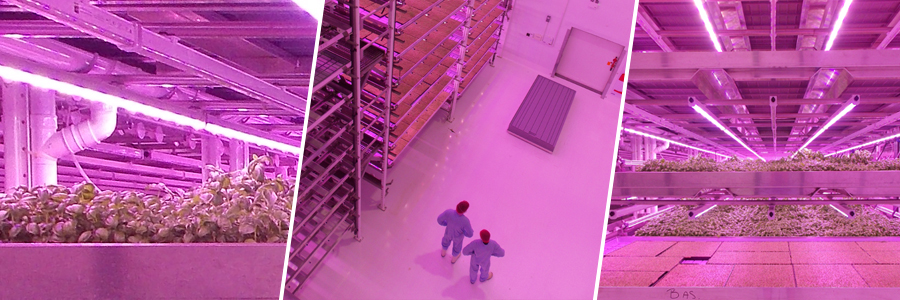Phoebe Sutton explains how her commercially-led PhD with May Barn Consultancy, co-founders of the largest plant factory in the UK, will help address hidden hunger and promote green growth.
Pulling into the industrial estate, you would be dubious that this was arable farmland. However, May Barn Consultancy, in partnership with the Jones Food Company (JFC), have made it just that. Sealed inside a converted cold-store warehouse, futuristic techniques grow commercial produce using urban vertical farming.
What is Vertical Farming?
Vertical farming comes in many forms; our particular system pairs hydroponic horticulture - a method of growing plants in a non-soil substrate and liquid fertiliser - with LED lighting technology. Layers of plants are stacked in shelves, with each shelf illuminated by LED lighting attached to the underside of the shelf above. As a closed loop system, this can conserve up to 90% of water in comparison to soil-based farming methods. It is not surprising that vertical farming systems can supply more produce per square meter than conventional methods, and in unconventional places such as rooftops or even underground!
At the ‘high care’ JFC farm, staff and visitors are dressed in sterile overalls, hairnets and boots, and pass through an ‘air shower’, which blows away any stray particles, before entering the positive pressured growth room. Such precautions minimise any risk of contamination to the produce from people or pests. Inside, a sophisticated computer system maintains room temperature, carbon dioxide and humidity at optimum levels for plant growth all year round. As a result, plants burst out of imposing towers of shelves 17 rows high, bathed in the pink glow of Current, powered by General Electric, horticultural LEDs that are designed to supply plant-loving red and blue light. However, the proportions of each colour are not currently optimised to the specific crops being grown, which is where I come in.
Combining Photobiology and Commercial Business
To plants, light quality is of central importance. Light is not only used by plants to make food, but particular colours of light inform plants when to grow and determine how tall they will become and what their leaves look like. Recent research has found that specific wavelengths also control vitamin production in plants, opening the possibility of increasing the nutritional content of the produce grown in the JFC facility through changes in light alone.
Horticultural LEDs currently supply a one-size-fits-all ratio of red and blue light (usually around 80:20) but the technology is rapidly developing towards tuneable LED units. This means it will soon be possible to supply plants with a designed red and blue light recipe to improve desired traits, such as nutritional content. However, individual plant species react differently to these colours. Therefore, May Barn Consultancy sought a collaboration with Lancaster University to establish the responses of their crops to light quality.
My PhD project is focused on experimenting with the high-value herbs basil and coriander under mixes of red and blue light, observing how they react physiologically and in the accumulation of pro-vitamin A, vitamin E and vitamin C, the most vital micronutrients to human health. Already it is clear from their different growth patterns under 100% red or blue light that these crops have unique preferences for the colours, which change from seedling to mature plants. Now, 18 months into my PhD, I am growing plants under mixed ratios of red and blue light and beginning to analyse samples for vitamin content.
This novel work will increase our understanding of the role of photobiology in vitamin production and demonstrate how such knowledge can be applied to the commercial sector to have real-world impact. For May Barn Consultancy and JFC, it will contribute to an optimised lighting regime engineered to maximise the nutritional value of their crops and help to address a hidden hunger of micronutrient deficiencies in modern day society, without the use of invasive gene editing technologies.
I am excited to be a part of the next stage of the vertical farming movement in partnership with the UK pioneers, May Barn Consultancy and JFC. All this would not be possible without the support of the award winning Centre for Global Eco-Innovation, which is based at the Lancaster Environment Centre and part funded by the European Regional Development Fund. It brings together universities and small to medium sized enterprises, with the aim of promoting the efficient use of natural resources and growing sustainable business.
Find out more about PhDs at the Lancaster Environment Centre.
Disclaimer
The opinions expressed by our bloggers and those providing comments are personal, and may not necessarily reflect the opinions of Lancaster University. Responsibility for the accuracy of any of the information contained within blog posts belongs to the blogger.

